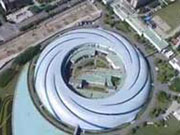China's 1st national science center taking shape

 0 Comment(s)
0 Comment(s) Print
Print E-mail CNTV, March 10, 2016
E-mail CNTV, March 10, 2016
China's latest government work report says the country will continue to build first-class national science centers and technological innovation hubs. It shows innovation has become the primary driving force behind the country's economic development.
Approved by the Ministry of Science and Technology, the National Science Center is aimed at improving China's competitiveness on the global stage in science and technology. Its construction is expected for completion by 2020.
This nautilus-like construction is Shanghai Synchrotron Radiation Facility, or SSRF, a core of the center.
The findings of Huang Yaobo and his team on a new particle, was listed as "China's top ten progress in science and technology" in 2015. It was awarded the "breakthrough of the year" by Physics World Magazine.
"Here's our system. The big tube is where the x-ray goes out. After the beamline we have this station, the main experimental chamber and the preparation part for the samples…The reason we select this place, in Zhangjiangpark, Shanghai, is that this radiation facility is the third generation facility with much higher resolution. We can compare with developed countries, their institutions and universities. We can do the best in science," Huang Yaobo, associate researcher iwht Shanghai Institute of Applied Physics, CAS, said.
Other research facilities in the National Science Center also include the National Center for Protein Science, as well as Shanghai Supercomputer Center.
By 2020, China's R&D investment will account for 2.5 percent of GDP. Grappling with a possible economic downturn, China is counting on innovation to assist a shift in economic engines.
"Like the phase two project, we're going to have 16 more new beamlines to enhance its experimental capability, to serve more international user from different researching fields, in physics, chemistry, biology, life science, environment, and medicine," Zhao Zhentnag, director of Shanghai Synchrotron Radiation Center, said.
The National Science Center can consolidate all resources and experiments on institutional innovations, and overcome stumbling blocks such as an insufficient originality, a lack of commercialized research, as well as a shortage of high-end talent.
In Chinese, the name of Synchrotron Radiation Facility is 'the source of lights'. With hundreds of scientists and experts working on the same platform everyday, it is not only the source of light, but also the source of new thoughts, new findings, innovation and creation.





